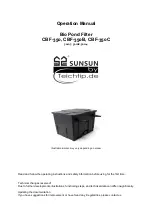
23
Vent pipes supported only by flashing and extended
above the roof more than 5 ft should be securely
guyed or braced to withstand snow and wind loads.
The air inlet opening MUST be installed 1 ft above the
roof line or above normal snow levels that might ob-
struct combustion air flow. This dimension is critical to
the correct operation of the heater and venting system
and reduces the chance of blockage from snow. The
vent cap must have a minimum 3 ft vertical clearance
from the air inlet opening.
Use only the special gas vent pipes listed for use with
Category III gas burning heaters, such as the AL29-4C
stainless steel vents offered by Selkirk Inc. (1-800-
992-VENT or 1-800-992-8368 in the US, or 1-888-
SEL-KIRK or 1-888-735-5475 in Canada), Protech
System, Inc. (800-766-3473), Z-Flex (800-654-5600)
or American Metal Products (800-423-4270). Pipe
joints must be positively sealed. Follow the vent man-
ufacturer’s installation instructions carefully.
Outdoor Installation
The stackless top provided with the heater is the stan-
dard venting method for outdoor installations. The
stackless top may be used in its standard top-mounted
configuration or moved to the rear of the heater for a
rear-exhaust configuration. See the diagram below.
A few reasons why the rear stackless top may be con-
sidered are:
a) It reduces the chance of water infiltration, espe-
cially in snowy areas.
b) It relieves lot line restrictions.
c) It is easier to service the heater.
Care must be taken when locating the heater out-
doors, because the flue gases discharged from the
vent cap can condense as they leave the cap.
Improper location can result in damage to adjacent
structures or building finish. For maximum efficiency
and safety, the following precautions must be
observed:
1. Periodically check venting system. The heater’s
venting areas must never be obstructed in any
way and minimum clearances must be observed
to prevent restriction of combustion and ventilation
air. Keep area clear and free of combustible and
flammable materials.
2. Do not locate adjacent to any window, door, walk-
way, or gravity air intake. The vent must be locat-
ed a minimum of 4 ft horizontally from such areas.
3. Install above grade level and above normal snow
levels.
4. Vent terminal must be at least 3 ft above any
forced air inlet located within 10 ft.
5. Adjacent brick or masonry surfaces must be pro-
tected with a rust-resistant sheet metal plate.
** Subtract 10 ft per elbow. Max. 4 elbows.
Table G: Category III Horizontal Vent & Horizontal Direct Vent
Model
No.
Certified
Vent
Material
Vent
Size
(in.)
Maximum
HorizontalVent
Length (ft)**
Combustion Air
Intake Pipe
Material
Air Intake
Max. Length** (ft)
4” Ø
409B
Category III
6
80
Galvanized Steel,
PVC,
ABS,
CPVC
80
259B
409B
5
40
259B
80
259B
4
40
NOTE:
Condensate can freeze on the vent cap.
Frozen condensate on the vent cap can result in a
blocked flue condition.
Содержание 259B
Страница 13: ...13 Florida Building Code Fig 6 Florida Building Code 2010 Tie Down Method...
Страница 32: ...32 WIRING DIAGRAM...
Страница 44: ...44 SECTION 6 REPLACEMENT PARTS...
Страница 48: ...www raypak com Raypak Inc 2151 Eastman Avenue Oxnard CA 93030 805 278 5300 Fax 805 278 5468 Litho in U S A 48...
















































